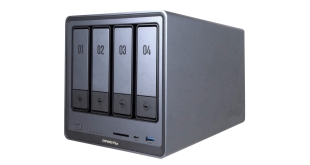
After putting the Installation CD into our DVD-drive we were faced with a simple ‘Begin Installation' option. We pressed begin and followed a very simple set-up procedure which required little user input. It only took a minute or two to complete.

After the installation we were given the option to install more software. None of this is required to use the device some of it may well be useful.
We were then able to use the NAS Navigator 2 to find our NAS device and load up the settings. The first page allows us to set an admin password.
We are then given a webpage with ‘5 easy options' and an advanced settings option. From this page you can turn on or off and access the settings for the Web Access feature, the BitTorrent client, DLNA and the USB Device Server, or you can chose the Advanced Settings option.
The advanced setting option gives you a lot more options to configure your LinkStation NAS device. The first menu option allows you to adjust the file sharing settings, including setting up folders and FTP.
If you want to add a folder to the device, these settings will allow you to adjust the attributes, permissions and access types.
The next menu option allows you to alter the drive configurations. This includes altering the device from Raid 0 to Raid 1 or theoretically as JBOD.
The third page allows you to adjust the services that run on the device, these include; DLNA Server, iTunes Server, USB Device Server and Print Server.
The next page is dedicated to the BitTorrent client, a peer-to-peer protocol for file-sharing. This could be a great alternative to a download manager, as it will allow you to schedule the download to run over the night while your computer is turned off, for instance.
The network settings page allows you to alter the IP address of the device, the workgroup/domain that the device belongs to, and it also allows you to run a ping test to any IP address.
The Buffalo LinkStation LS421DE also includes a built-in back-up facility which will allow you to set-up an automatic back-up to another LinkStation TeraStation or external HDD plugged into the device. Or if you have a MAC you can use the Buffalo LinkStation as a back-up destination for the Time Machine feature.
The last page of the advanced settings is the Management page, allowing you to alter some fundamental settings like time and date as well as being able to update the firmware or reset the device.
 KitGuru KitGuru.net – Tech News | Hardware News | Hardware Reviews | IOS | Mobile | Gaming | Graphics Cards
KitGuru KitGuru.net – Tech News | Hardware News | Hardware Reviews | IOS | Mobile | Gaming | Graphics Cards













